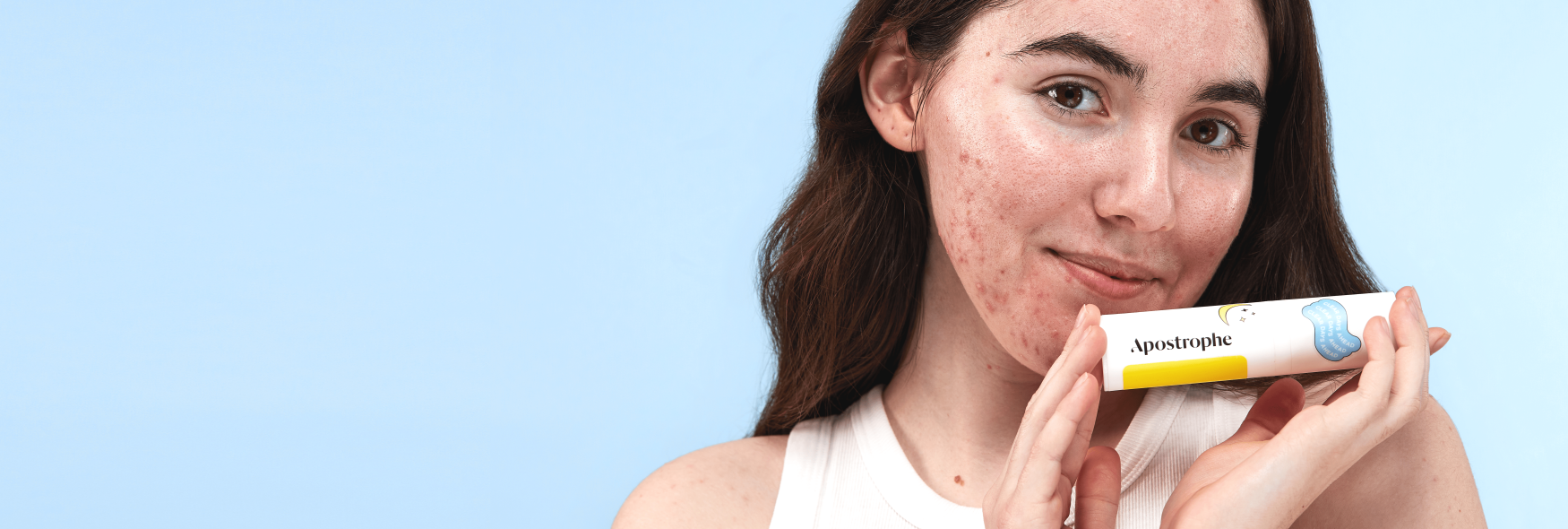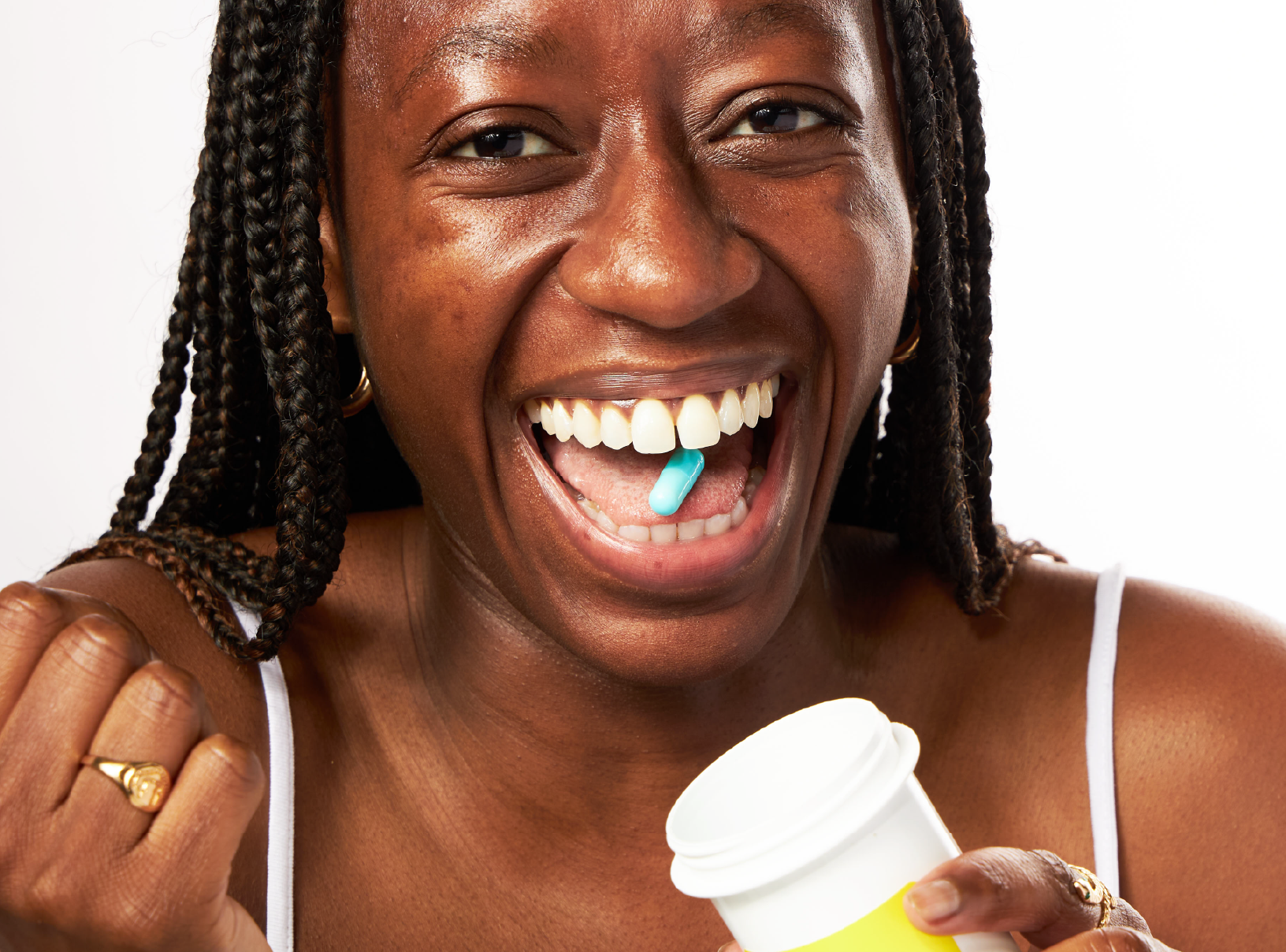Education
How does acne form?


SHARE
Education
How does acne form?
Medically reviewed by Katelyn Hagerty FNP
Written by Apostrophe Team
Last updated 11/3/2024
Unless you're extremely lucky and have enjoyed blemish-free skin your whole life, then you've probably dealt with your fair share of acne.
Acne is a skin condition that notoriously affects adolescents, but in some instances, may go on to appear on the faces, chests, or backs of adults. In other cases, it may even arise in newborns and young children.
This condition is very common, affecting around 9.4% of the world's population. We'll be looking at the causes of acne to understand why so many people have to deal with it, as well as the different types. We'll also be sharing acne treatment tips to help with managing acne.
Types of Acne
Typically, if it grows out of your skin and looks tempting enough to be popped, then it's most likely acne. However, there are distinctions to be made — acne may be inflammatory or non-inflammatory. Under these, there are mild, moderate, and severe forms of acne.
Mild Acne
These are non-inflammatory forms of acne that do not affect the surrounding skin. They appear as comedones (i.e. bumps that pop up due to clogged skin pores). Their most common forms are open or closed comedones.
When the bump remains underneath the skin surface, it is a closed comedone known as a whitehead or pimple. When the skin over the bump is open, the melanin pigment reacts with oxygen in the air, causing the bump to darken into a blackhead.
Acne gets a mild rating where there are only a few pimples or none at all.
Moderate acne
If you have moderate acne, then you have more than a few acne pimples around your face, back, chest, or other parts of your body.
Since we're already building your acne vocabulary, note that these pimples may be papules or pustules.
Papules are small, inflamed bumps on your skin, while pustules are usually bulging bumps, filled with yellow pus.
Severe Acne
A face with severe acne will have a lot of papules and pustules to deal with. It may also have nodules and cysts, which are blemishes that can cause inflammation deep in the skin.
These forms of acne are usually painful and may lead to scarring.
How Acne Forms
During your teenage years, your body is undergoing puberty through changes regulated by hormones such as androgens.
Androgens are male sex hormones that are also produced by females during puberty.
Androgens are needed in large amounts for processes like breast development and sexual hair growth, but their increased presence also causes higher concentrations of oil in the body.
Now ordinarily, this shouldn't be a problem as your skin needs sebum (oil) for protection, and to stay moisturized.
However, this oil is produced in glands located in the skin and is highly concentrated on the face, the upper chest, and the back, which just so happen to be acne hotspots.
The oil produced is deposited on the skin surface for your body's needs through pores that are connected to the hair follicle.
But because the skin is constantly making new skin cells to replace old ones, there is a chance that accumulated dead skin cells can block the pores.
When this happens, the cells will prevent the glands located underneath the skin from being able to deposit oil on the skin surface. This can lead to a build up in the oil gland.
Combine this with bacteria that live on the skin surface, and you have a mixture of oil, dead skin cells, and microorganisms which can lead to inflammation.
When the wall of a follicle becomes inflamed, this can cause the bacteria, sebum, and cells to spill to nearby skin, causing acne.
Factors That Increase The Risk of Acne
13-20 may be the golden breakout years, but other factors beyond puberty may be responsible for the appearance of acne. They include:
Genetics
Along with dimples or an increased athletic ability, your mom may have given you an increased risk of acne when she was passing her genes on to you.
Studies have shown that a family history of acne may increase the chances of children developing acne. There's also a chance that severe acne may be a genetic inheritance, but the jury's still out on that.
Skin Type
If oily skin is your pick for the skin type most likely to develop acne, you’d be 100% correct. This is because its high sebum content leaves skin pores prone to blockage. The oil can mix with dead skin cells and bacteria to cause breakouts. However, the chances of breaking out may be just as high if you have dry skin.
Diet
Your diet can be a big reason you're breaking out, and when it comes to foods most likely to cause acne, we may have some bad news.
Chocolate, cookies, as well other foods that can increase blood sugar may pose an increased risk for acne. Likewise, high-fat foods like deep-fried chicken may increase the risk of developing acne.
Medication
If you’ve been taking medication to manage your mood or inflammation, and you just so happen to be dealing with a fresh round of acne — you should know that certain drugs increase the risk of experiencing breakouts.
These drugs include lithium, steroids, as well as certain anticonvulsants for managing seizures.
Acne Treatment Options
Whether you're dealing with mild, moderate, or severe acne, there are a number of treatment options to help with managing your condition. These include:
Topical Treatments
These are the standard measures for managing mild to moderate acne. They include:
Retinoids
Topical retinoids help to reduce acne by preventing the blockage of the follicle. They also have anti-inflammatory effects and can help to reduce the number of comedones in the skin.

PRESCRIPTION TRETINOIN
Target acne, dark spots, and signs of aging with this science-backed ingredient.
This treatment may, however, come with the side-effect of red, irritated skin and scaling when first starting out.
Benzoyl Peroxide
Helps to kill acne-causing bacteria under the skin by releasing oxygen into the follicle. This treatment also has moderate effects in preventing the build-up of dead skin cells, oil, and bacteria in the pores.
It also has modest anti-inflammatory properties. A little thing to note is that benzoyl peroxide can act as a bleaching agent so be cautious of your clothes and towels when using it.
Antibiotics
When you need big guns to help manage acne, antibiotics may be a preferred option. This measure is necessary where topical treatments are unable to properly manage acne, or perhaps led to irritation.
It is a suitable option for moderate to severe acne. Antibiotics help to kill off acne-causing bacteria.
They also provide anti-inflammatory support against acne. Antibiotics may be used as an oral or topical treatment.
Hormonal Therapies
Estrogen, the female sex hormone, may also be effective in reducing the appearance of acne.
Oral contraceptives that contain this hormone may help to decrease the levels of the androgen testosterone, a known cause of acne.
This hormone is also helpful in suppressing the production of sebum when given in sufficient amounts.
Isotretinoin
For severe acne like nodules and cysts, isotretinoin's ability to reduce the size of the sebaceous glands, as well as sebum production.
It also has the ability to lower acne-causing bacteria, with the added bonus of anti-inflammatory abilities.
Other measures like using sunscreen daily, and avoiding cosmetic products that can clog your pores may help in managing acne.
Treating Acne
Whether mild, moderate or severe, acne can be a pain to deal with.
This condition usually forms following a blockage in skin pores, and may be managed using topical treatments, antibiotics or hormonal therapies.
If you have acne and want the best results when getting rid of it, consulting with a dermatology team first can help in making the right decision.
References
Poole CN, McNair V. Infantile Acne. In: StatPearls [Internet]. Treasure Island (FL): StatPearls Publishing; 2021 Jan-. Retrieved from: https://www.ncbi.nlm.nih.gov/books/NBK541124/|
Tan, J. K., & Bhate, K. (2015). A global perspective on the epidemiology of acne. The British journal of dermatology, 172 Suppl 1, 3–12. Retrieved from: https://onlinelibrary.wiley.com/doi/full/10.1111/bjd.13462|
Rogol, A. D., Roemmich, J. N., & Clark, P. A. (2002). Growth at puberty. The Journal of adolescent health : official publication of the Society for Adolescent Medicine, 31(6 Suppl), 192–200. Retrieved from https://www.researchgate.net/publication/11000729_Growth_at_Puberty|
Cleveland Clinic. (n.d.). Acne. https://my.clevelandclinic.org/health/diseases/12233-acne|
Endly, D. C., & Miller, R. A. (2017). Oily Skin: A review of Treatment Options. The Journal of clinical and aesthetic dermatology, 10(8), 49–55. Retrieved from: https://www.ncbi.nlm.nih.gov/pmc/articles/PMC5605215/|
Pappas A. (2009). Epidermal surface lipids. Dermato-endocrinology, 1(2), 72–76. Retrieved from: https://www.ncbi.nlm.nih.gov/pmc/articles/PMC2835894|
Niams.nih.gov (n.d). Acne. Retrieved from: https://www.niams.nih.gov/health-topics/acne/advanced|
Yang, J., Yang, H., Xu, A., & He, L. (2020). A Review of Advancement on Influencing Factors of Acne: An Emphasis on Environment Characteristics. Frontiers in public health, 8, 450. Retrieved from: https://www.ncbi.nlm.nih.gov/pmc/articles/PMC7527424/|
Endly, D. C., & Miller, R. A. (2017). Oily Skin: A review of Treatment Options. The Journal of clinical and aesthetic dermatology, 10(8), 49–55. Retrieved from:
Heng, A., & Chew, F. T. (2020). Systematic review of the epidemiology of acne vulgaris. Scientific reports, 10(1), 5754. Retrieved from: https://www.ncbi.nlm.nih.gov/pmc/articles/PMC7113252/|
Sutaria AH, Masood S, Schlessinger J. Acne Vulgaris. In: StatPearls [Internet]. Treasure Island (FL): StatPearls Publishing; 2021 Jan-. Retrieved from: https://www.ncbi.nlm.nih.gov/books/NBK459173/|
Kraft, J., & Freiman, A. (2011). Management of acne. CMAJ : Canadian Medical Association journal = journal de lAssociation medicale canadienne, 183(7), E430–E435. Retrieved from: https://www.ncbi.nlm.nih.gov/pmc/articles/PMC3080563/#:~:text=Topical%20therapy%20is%20the%20standard%20of%20care%20for%20mild%20to%20moderate%20acne.&text=Retinoids%20and%20antimicrobials%20such%20as,they%20can%20prevent%20new%20lesions.|
Ebede, T. L., Arch, E. L., & Berson, D. (2009). Hormonal treatment of acne in women. The Journal of clinical and aesthetic dermatology, 2(12), 16–22. Retrieved from: https://www.ncbi.nlm.nih.gov/pmc/articles/PMC2923944/#:~:text=While%20testosterone%20and%20DHT%20have,and%20inhibition%20of%20testosterone%20secretion.|
Pile HD, Sadiq NM. Isotretinoin. In: StatPearls [Internet]. Treasure Island (FL): StatPearls Publishing; 2021 Jan-. Retrieved from: https://www.ncbi.nlm.nih.gov/books/NBK525949/|
Layton A. (2009). The use of isotretinoin in acne. Dermato-endocrinology, 1(3), 162–169. Retrieved from: https://www.ncbi.nlm.nih.gov/pmc/articles/PMC2835909/
Like what you just read? Sign up for our email list to get the scoop on skincare science delivered straight to your inbox.

Deep Dives
A dermatologist shares his thoughts on the recent studies about benzoyl peroxide and benzene.
Read More
Education
What is milia?
What is milia? Today, we’re jumping into one type of bump that you may have heard about most commonly in infants — milia.
Read More
Education
Best moisturizer for acne-prone skin
If you have combination acne-prone skin, figuring out which moisturizer is best for your skin might be tough. In this guide, we break down the best moisturizer for combination, acne-prone skin.
Read More
